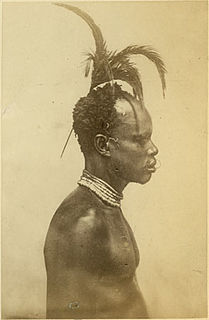The Lotuko people, also known as the Latuka or Otuho, are a Nilotic ethnic group whose traditional home is the Eastern Equatoria state of South Sudan. Their population is around 241,000.
The Nilotic peoples are peoples indigenous to the Nile Valley who speak Nilotic languages, which constitute a large sub-group of the Nilo-Saharan languages spoken in South Sudan, Uganda, Kenya, and northern Tanzania. In a more general sense, the Nilotic peoples include all descendants of the original Nilo-Saharan speakers. Among these are the Luo, Sara, Maasai, Kalenjin, Dinka, Nuer, Shilluk, Ateker, and the Maa-speaking peoples, each of which is a cluster of several ethnic groups. Some ethnic groups in West Africa such as the Serer people of Senegal, the Gambia and Mauritania have been reported as being of Nilotic origin.

Eastern Equatoria is one of the ten states of South Sudan. It has an area of 73,472 km². The capital is Torit.

South Sudan, officially known as the Republic of South Sudan, is a landlocked country in East-Central Africa. The country gained its independence from the Republic of the Sudan in 2011, making it the newest country with widespread recognition. Its capital and largest city is Juba.
Contents
The Lotuko are bordered by the Lokoro in the North, the Bari on the West, the Acholi and the Madi in the South, and the Didinga and the Boya in the East. Their region is characterized by ranges and mountain spurs such as the Imotong mountain, the highest mountain in South Sudan with an altitude of 10,453 ft above sea level. It is divided into 5 major sub-regions: Imatong, Valley, Dongotolo, Lopit, and the Great Plains.

The Bari people, also known as the Karo, are a Nilotic ethnic group mainly inhabiting South Sudan, as well as adjacent parts of northwestern Uganda. They are known as the Duor by other communities occupying the savanna lands of the White Nile. The Bari speak the Bari language as a mother tongue, which belongs to the Nilo-Saharan family.

The Mà'dí people live in Pageri County in South Sudan, and the districts of Adjumani and Moyo in Uganda. From south to north, the area runs from Nimule, at the South Sudan-Uganda border, to Nyolo River where the Ma’di mingle with the Acholi, the Bari, and the Lolubo. From the east to west, it runs from Parajok/Magwi to Uganda across the River Nile.
The Didinga (diDinga) occupy the Didinga Mountains region in Budi County, Eastern Equatoria State in South Sudan. They live in the valleys, on the plateaus and slopes, and on the adjacent plains of the region. Their neighbors include the Toposa, the Boya, Ketebo, Logir, Teuth and Dongotona peoples - groups with whom the Didinga have had frequent conflicts due to economic pressures.
As agro-pastoralists, they keep large herds of cattle, sheep and goats, and supplement this with hoe-farming, hunting, and fishing. [1] They engage in some subsistence agriculture; their main crops are sorghum, ground nuts, simsim (sesame), and maize in the plains, or telebun, dukhn, sweet potatoes, and tobacco in the hills. [2]

Hoe-farming is a term introduced by Eduard Hahn in 1910 to collectively refer to primitive forms of agriculture, defined by the absence of the plough. Tillage in hoe-farming cultures is done by simple manual tools such as digging sticks or hoes. Hoe-farming is the earliest form of agriculture practiced in the Neolithic Revolution. Early forms of the plough (ard) were introduced throughout the Near East and Europe by the 5th to 4th millennium BC. The invention spread throughout Greater Persia and parts of Central Asia, reaching East Asia in the 2nd millennium BC.

Subsistence agriculture occurs when farmers grow food crops to feed themselves and their families. In subsistence agriculture, farm output is targeted to survival and is mostly for local requirements with little or no surplus trade. The typical subsistence farm has a range of crops and animals needed by the family to feed and clothe themselves during the year. Planting decisions are made principally with an eye toward what the family will need during the coming year, and secondarily toward market prices. Tony Waters writes: "Subsistence peasants are people who grow what they eat, build their own houses, and live without regularly making purchases in the marketplace."

Sorghum is a genus of flowering plants in the grass family Poaceae. Seventeen of the 25 species are native to Australia, with the range of some extending to Africa, Asia, Mesoamerica, and certain islands in the Indian and Pacific Oceans. One species is grown for grain, while many others are used as fodder plants, either cultivated in warm climates worldwide or naturalized, in pasture lands. Sorghum is in the subfamily Panicoideae and the tribe Andropogoneae.
The Murle people have recently raided the Lokuto, the Lopit, and other tribes in the area, abducting their children. [3]
The Murle are a Nilotic ethnic group inhabiting the Pibor County and Boma area in Jonglei State, South Sudan, as well as parts of southwestern Ethiopia. They have also been referred as Beir by the Dinka and as Jebe by the Luo and Nuer, among others. The Murle speak the Murle language, which is part of the Surmic branch of the Nilo-Saharan family. The language cluster includes some adjoining groups in Sudan, as well as some non-contiguous Nilotic populations in southwestern Ethiopia.

The Lopit people are an ethnic group found in Eastern Equatoria State, South Sudan. Traditionally, they refer to themselves as donge (plural) or dongioni (singular). The Lopit number 160,000 to 200,000 people living in the Lopit area, in the Lopit mountains which extend from the east to the north of Torit.
Land is owned by no single person, but in trust by the community. In the mountains, after finding a site, the group decides the boundaries of each person's garden, with certain areas being fallow (for up to 10 years) and others open to cultivation (for up to 4 years). [4]






